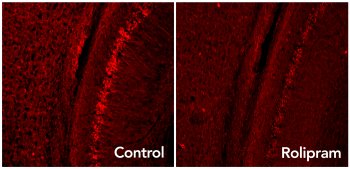
 To remain healthy, brain cells must continually clear out old, worn, or damaged proteins, a task performed by a small molecular cylinder called the proteasome. The proteasome acts as a kind of garbage disposal, grinding up the old proteins so they can be recycled into new ones. In neurodegenerative diseases such as Alzheimer’s, Parkinson’s, and Huntington’s, proteins tagged for destruction accumulate in the brain’s neurons, suggesting that the cell’s proteasomes are impaired.
To remain healthy, brain cells must continually clear out old, worn, or damaged proteins, a task performed by a small molecular cylinder called the proteasome. The proteasome acts as a kind of garbage disposal, grinding up the old proteins so they can be recycled into new ones. In neurodegenerative diseases such as Alzheimer’s, Parkinson’s, and Huntington’s, proteins tagged for destruction accumulate in the brain’s neurons, suggesting that the cell’s proteasomes are impaired.
Using a genetically engineered mouse, the researchers first discovered that tau—a protein that accumulates in Alzheimer’s, frontotemporal degeneration, and other brain diseases—sticks to the proteasome and slows down the protein disposal process.
“Something profoundly bad happens to proteasomes in diseases where abnormal proteins accumulate, ” said the study’s first author, Natura Myeku, PhD, an associate research scientist in the pathology and cell biology department at CUMC. “Our work on tau showed that even when proteasomes are removed from the diseased brains they remain defective and can’t chew up proteins compared with proteasome from normal brains.”
Administering rolipram activated the proteasome and restored protein disposal. The drug also improved memory in diseased mice to levels seen in healthy mice.
Rolipram has been tested before in mice, and was shown to improve memory. But the new research shows a previously unknown function of the drug that produces a physical change in the proteasome and increases its activity.
“We have uncovered a mechanism by which we can activate proteasomes, ” said Dr. Myeku. “However, we still don’t have a full picture how those changes cause proteasomes to become super proteasomes that are able to remove toxic proteins from the brain. For now, it’s exciting to know that brain proteasomes can be repaired, which will allow us to develop better drugs.”
Drugs that target proteasomes in this way should work for any neurodegenerative disease caused by the accumulation of abnormal proteins, including Alzheimer’s, frontotemporal degeneration, Huntington’s, and Parkinson’s.
Dr. Duff noted, “Even though much work has been done, we still don’t know exactly which form of a particular protein is toxic to the brain. This has made it difficult to develop drugs to treat neurodegenerative diseases. In Alzheimer’s disease, the problem is compounded because several types of abnormal protein can accumulate in a person’s brain, including amyloid, tau, alpha-synuclein, and TDP43. We think that a well-functioning proteasome will be able to clear out everything at once.”
“This exciting research from Dr. Duff’s team advances our basic understanding of the proteasome system, provides a way to repair the system when it breaks, and holds the potential to alleviate symptoms of neurodegenerative disorders, ” said Rod Corriveau, PhD, program director at the National Institute of Health’s National Institute of Neurological Disorders and Stroke, which provided funding for the study.
About the paper:
The study is titled, “Tau-driven 26S proteasome impairment and cognitive dysfunction can be prevented early in disease by activating cAMP-PKA signaling.” The other contributors are: Catherine L. Clelland (CUMC), Sheina Emrani (CUMC), Nikolay V. Kukushkin (Harvard Medical School), Wai Haung Yu (CUMC) and Alfred L. Goldberg (Harvard Medical School).
The study was supported by grants from the National Institute of Neurological Disorders and Stroke, the CurePSP Foundation, the National Institute of General Medical Sciences, the Fidelity Biosciences Research Initiative, and the Multiple Myeloma Research Foundation.
The researchers declare no financial or other conflicts of interest.
Columbia University Medical Center provides international leadership in basic, preclinical, and clinical research; medical and health sciences education; and patient care. The medical center trains future leaders and includes the dedicated work of many physicians, scientists, public health professionals, dentists, and nurses at the College of Physicians and Surgeons, the Mailman School of Public Health, the College of Dental Medicine, the School of Nursing, the biomedical departments of the Graduate School of Arts and Sciences, and allied research centers and institutions. Columbia University Medical Center is home to the largest medical research enterprise in New York City and State and one of the largest faculty medical practices in the Northeast. For more information, visit cumc.columbia.edu or .
RELATED VIDEO











